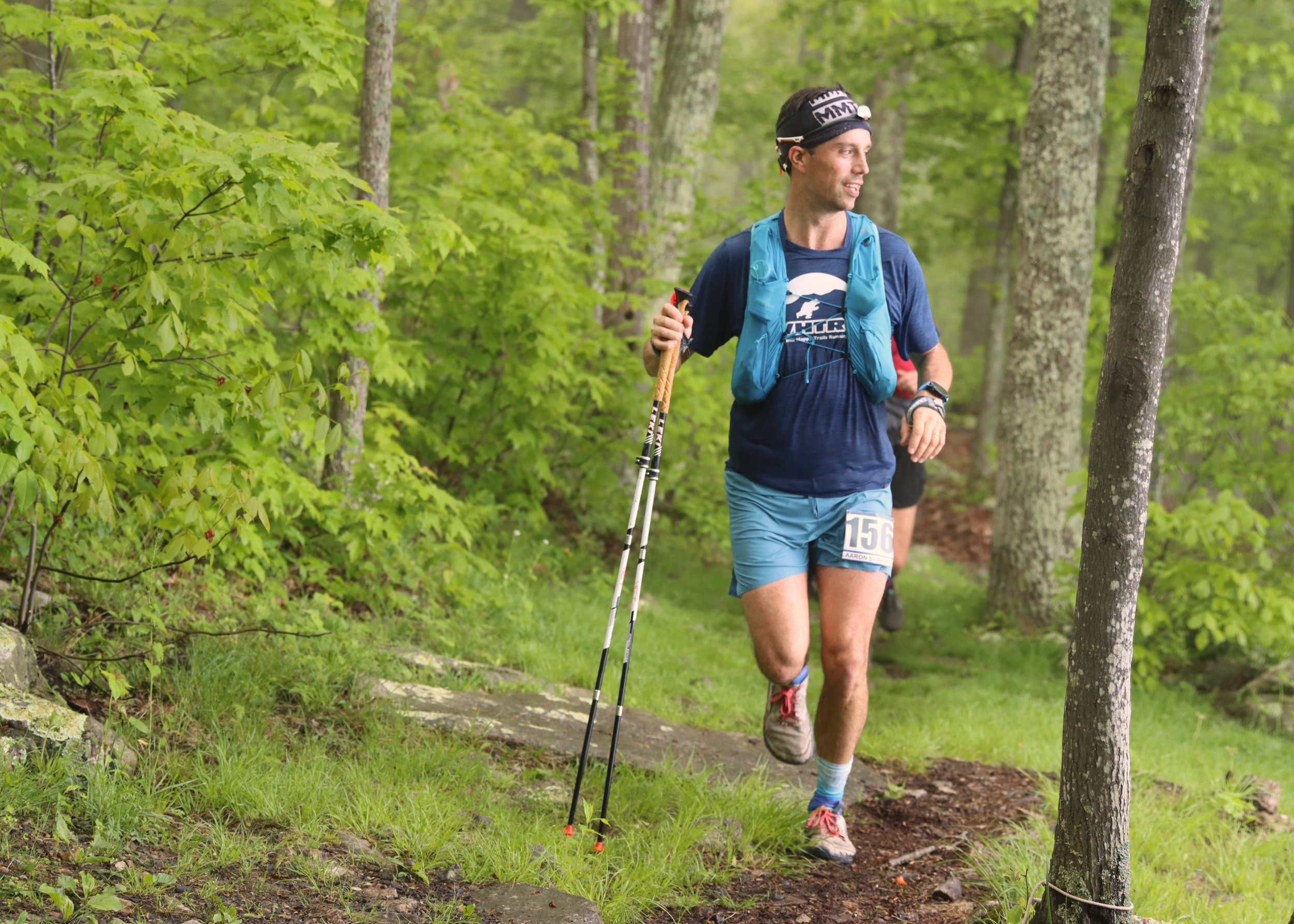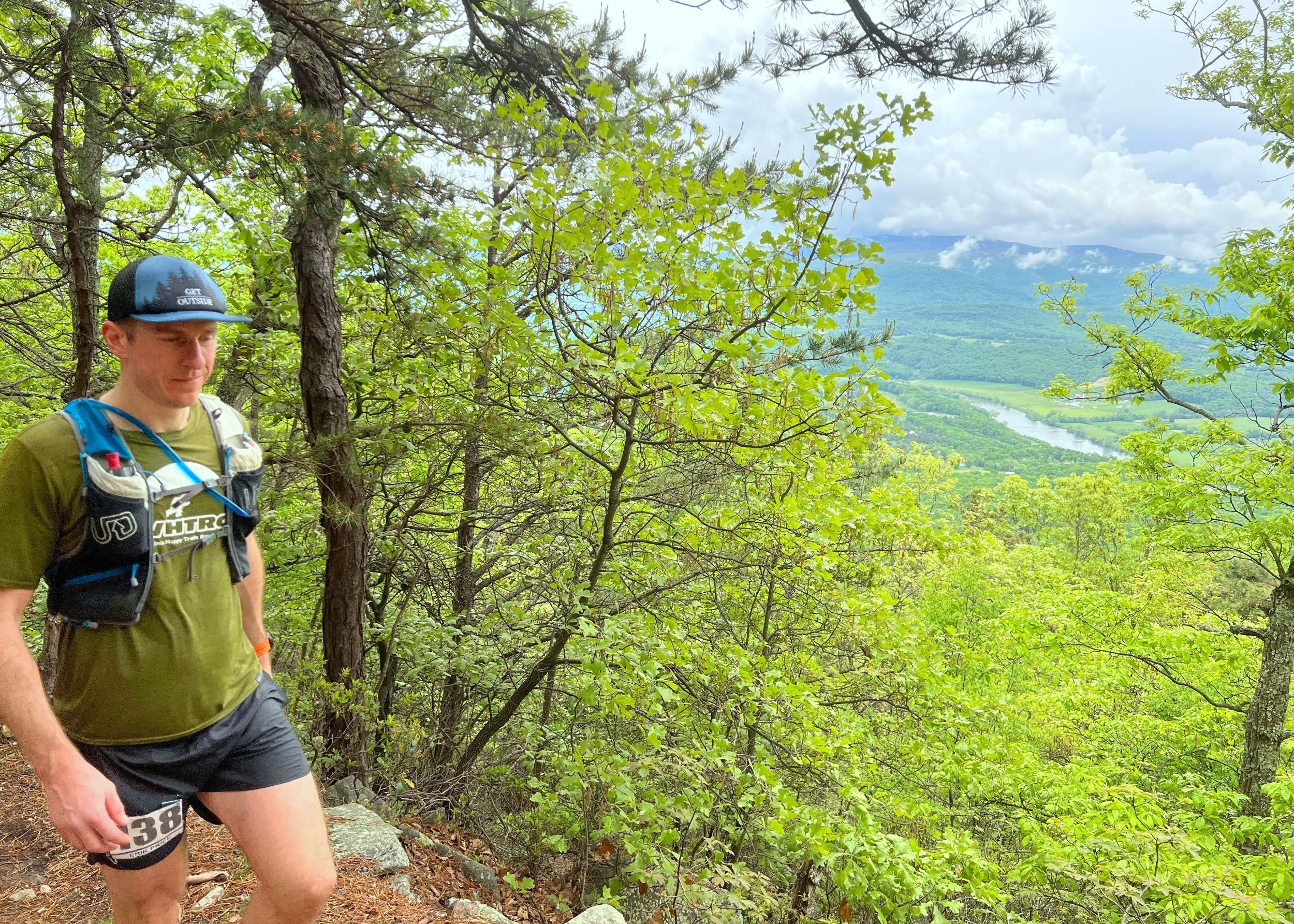Entry is open
Caroline Furnace Lutheran Camp, the start/finish of the MMT 100, flanked by the East and West ridges of the Massanuttens.
Keith Knipling
A Race Worth Rallying For
by Erik Price
These mountains, their trails, this race, totally “rocks,” even now, almost 30 years since the inaugural Massanutten Mountain Trails 100 mile trail run. Or at least that’s the affectionate way mid-Atlantic runners refer to the steep, technical trails, littered with eroded sand- and limestone. Founded before the “ultra boom” of 100 milers popping up all over the country, “MMT” is one of the oldest, most traditioned trail races still held.
Like the race itself, these mountains are some of the oldest on Earth. While the nearby Shenandoah range is spectacular, boasting longer climbs and grandiose views of the region, the Massanuttens challenge runners to their fullest. Geologic synclines gave the area its distinctive canoe-shaped valleys and pushed shale rock skyward here; further erosion led to knife-edged outcroppings on the ridges for runners to traverse.
So what brings runners coming back year after year? After all, the trails are contemptible, breaking even the most experienced runners. While the course doesn’t appear as difficult on paper as big mountain western 100s, by my account, MMT is harder. The trails are tough, but the true challenge comes from the many variables involved. There are a dozen major climbs, which are relatively short by Rocky Mountain standards but, make no mistake, they are steep, technical ascents that never allow you to settle in and find a rhythm. There is mud, stream crossings, off-camber paths, oh and rocks – tons and tons of rocks. Large, small, slippery, loose, and jagged – they require your constant attention.
The weather isn’t exactly a selling point either. This year, the temperature was stable – hovering around the mid-70s during the day and in the 50s overnight – but the humidity soared, making for very sweaty conditions. In previous years, there have been heat waves, torrential downpours with waist-deep stream crossings, relentless bugs, or all of the above. These tumultuous conditions amount to a modest finisher rate hovering around 60% each year. It’s piecing that puzzle of unforgivably rocky trails, fickle weather, and extreme fatigue (the race starts at 4:00 AM) together that keeps many runners coming back. It may come as a surprise to know that there are 5, 10, 15, even 20-time finishers. Keith Knipling holds the record for MMT finishes with 21 now.
As with races across the world, an unfortunate low-point for MMT was COVID-19. Cancelling two years in a row was the obvious choice as the pandemic was largely an unknown, not to mention to the logistical complications and challenges of travel and obtaining volunteer support. Coming out of a pandemic, this year was especially memorable. Seeing runners suffer one hundred agonizing miles through the mountains of Virginia felt normal again.
When asked about what makes this race special, virtually every finisher cites the incredible volunteers and support staff. It’s obvious these aid stations are staffed by runners, with your every need already anticipated. The course markings are near idiot-proof, with confidence markers and taped-off side trails, though undoubtedly someone still manages to get lost each year.

The race is best summarized in the words of its runners:
Paul Jacobs, Washington D.C.
Paul Jacobs, winner of the 2022 race (and runner up in 2017) admittedly isn’t quite sure why he runs these trails. “It’s a great chance to connect with nature, spend a weekend with amazing people, and listen to my kids cheer me on.” He credits his faster time this year with the experience gained the first time. “Feeling the rhythms and patterns of the trails, the ascents, the ridge running, and subsequent descents helped put the frustrations out of focus.” Small variables like a loose rock, a soaked foot, or spotting poison oak fade away when realizing the full gravity of the 100-mile distance. Sharing these tribulations with such an incredible field makes it worth it, Jacobs went on to say. “Many Americans need more ways to find a community – Virginia Happy Trails Running Club is mine.”
Shalini Bhajjan, St. Louis, MO
Traveling from the St. Louis area, Shalini Bhajjan was less accustomed to the Massanutten trails than local runners. “On paper the course looks ‘runnable’, boasting 18,000 feet of gain, but its hard to understand how technical the course is.” Many “flat” sections are so rocky its more a balancing act than a run, and the steep climbs make “bombing the descents an extreme risk to your quads.” Still it was worth the trip: “The course is unique when compared with other 100 milers, provides reasonable crew access logistics, and offers a good taste of rugged Virginia wilderness, all framed by a beautiful backdrop in the George Washington National Forest.”
While the temperatures were moderate, the humidity was severe, described as Bajjan as “diabolical for managing fluids and calorie intake.” She also pointed out the importance and foot care to prevent blisters and chaffing, after a characteristically wet and clammy spring in Virginia. Her strategy worked well enough for a 2nd place female finish. If you are looking for a tough, east coast hundred she proclaims: “Put these steep and gnarly trails on your to-do list!”
Tracy Cooley, Arlington, VA
With a 60% finisher rate, that means 4 out of 10 starters will not finish MMT. Tracy Cooley found herself in this undesirable pool. Even after falling victim to late-day cut-offs, Tracy had only positive reflections: “Runners of all abilities love this race, even if late cut-offs are challenging. VHTRC offers the best of Virginia trail running and the spirit of the supporters make this a can’t miss event.” The race provides valuable lessons, to apply at a future attempt or at a less technical 100.
Erik Price, Falls Church, VA
For me, it was a tough return to the 100-mile distance. A successful 2019 venture at Cascade Crest in Washington State felt recent, but after the COVID-19 pandemic cancelations, the birth of my first child, and my worst running injury to date (a fractured sacrum), I was not the same runner as I had become accustomed to years earlier. While coming off a positive training cycle, this was still a come-back race. When I craft my “A”, “B”, and “C” goals, the pragmatist in me knows to set my sites somewhere between B and C. That put me between sub-30 and a “just buckle” mentality.

Feeling tired and fatigued early, I tried to settle into a steady, low-gear pace, however my plan quickly unraveled. I further deteriorated as I climbed 1,000 ft in 2 miles up Shawl Gap. Further into the heat of the day, I hit rock bottom and thoughts of dropping out crept into my head. Roughly half-way at the Habron Gap Aid Station, I was mentally and physically finished. Here I would eat, drink, stretch, even attempt to sleep on a tarp. Some friends at this aid station tried to rally me but to no avail. After spending over 90 minutes here, I jogged over to the race official to resign. I had the epiphany that if I was able to jog now, I could probably make it to the next aid station. My friend and training partner, “Moose” Larson, adjusted his plans to pace me, sealing the deal – I would march out. As evening set in and temperatures dropped, I kept moving forward and making up time, eventually hitting my goal of a 30-ish hour finish. One of the most amazing things about the 100-mile distance is that no matter how awful you feel, it is still possible to settle, renew, and rise like a phoenix from aid station ashes.
I swore off MMT immediately after finishing in 2018. Then the same thing happened this time around. Within a week though of mentally revisiting all those variables, the challenge became appealing enough to desire a future visit. It’s virtually impossible to finish this race and know you got everything right. As we’ve all seen – this race “rocks!”
Last updated June 21, 2022
